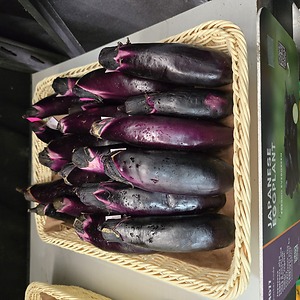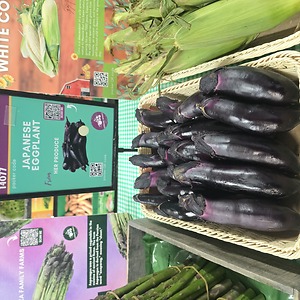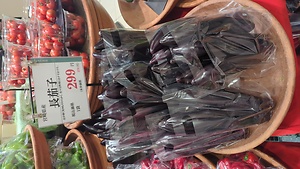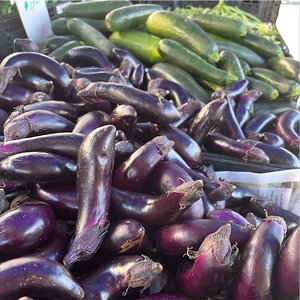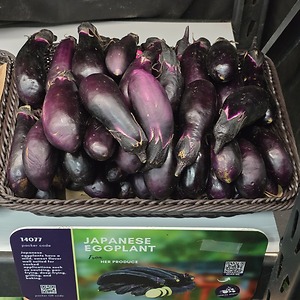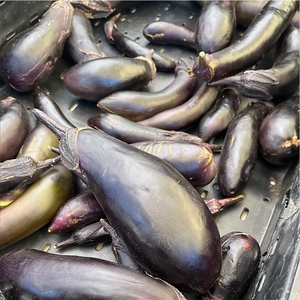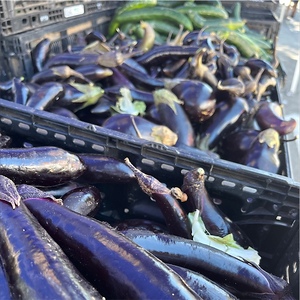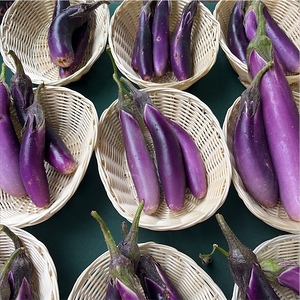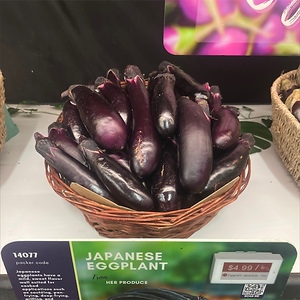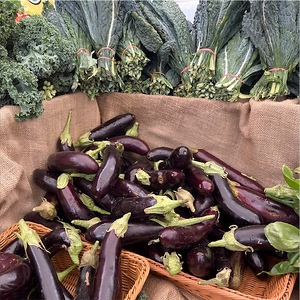


Japanese Eggplant
Estimated Inventory, 10 lbs : 14.19
This item was last sold on : 06/29/25
Description/Taste
Japanese eggplants are elongated and slender, averaging 20 to 25 centimeters in length, and have an oblong to cylindrical shape, tapering slightly at the ends. The eggplants may appear curved or straight and are capped with a green or dark purple stem, depending on the variety. The skin is thin, smooth, glossy, and delicate, easily damaged, and ranges in color from royal purple to dark purple, almost black. Underneath the surface, the cream-colored flesh is tinged with green and is nearly seedless with a dense, firm, and spongy texture. Japanese eggplants should feel heavy for their size and appear relatively unblemished for the best quality. The eggplants must be cooked before consumption and develop a soft, tender, and creamy consistency, readily absorbing sauces, spices, and aromatics. Japanese eggplants also have a sweet and mild flavor with subtle vegetal, earthy undertones.
Seasons/Availability
Japanese eggplants are available year-round, with a peak season in the summer through fall.
Current Facts
Japanese eggplants, botanically classified as Solanum melongena, are slender, purple-hued varieties belonging to the Solanaceae, or nightshade family. The name Japanese eggplant is used as a general descriptor for many different varieties of eggplants grown in Japan. Millionaire and Orient Express are the most common cultivars, but other varieties include Konasu, Kurume, Shoya Long, and Mangan. Japanese eggplants are also found in several shapes, from elongated and slender to oval with a tapered, bulbous appearance. Despite this variability, most eggplants labeled as Japanese in markets will be the dark purple cultivars with a long, slender, and tapered appearance. In the modern-day, Japanese eggplants are one of the most popular culinary ingredients for stir-fries and side dishes in Japan, and the variety is highly valued for its nearly seedless flesh, purple-coloring, and mild flavor. Beyond culinary uses, the eggplant’s unusual coloring has inspired nasu-kon, or eggplant blue, a color used for packaging, home décor, and art projects.
Nutritional Value
Japanese eggplants are a good source of vitamin C to strengthen the immune system while reducing inflammation and fiber to regulate the digestive tract. The eggplants also provide potassium to balance fluid levels within the body, folate to promote the growth of red blood cells, manganese to develop connective tissue, and other amounts of B vitamins, phosphorus, copper, magnesium, and vitamin K. In addition to vitamins and minerals, Japanese eggplants contain nasunin, a type of anthocyanin found in the purple skin that contributes antioxidant-like properties to protect the cells against free radical damage. The eggplants are also seen as a cooling culinary ingredient and are paired with warm, spicy flavorings to balance the body.
Applications
Japanese eggplants have a mild, sweet flavor well suited for cooked applications such as sautéing, pan-frying, deep-frying, grilling, and baking. The eggplant has thin skin that is left on in the cooking process, and the flesh has a porous nature, readily absorbing accompanying flavors. Japanese eggplant also retains its purple-hued skin, adding vibrant colors to stir-fries or roasted side dishes. The eggplant is popularly grilled to develop a smoky flavor, or grilled slices are tossed into salads for enhanced depth of flavor. In addition to grilling, Japanese eggplant can be roasted with spices as a side dish, mixed into dishes as a meat substitute, pureed into a dip, or incorporated into curries. The eggplant can also be chopped or sliced in half, braised in savory-sweet, rich sauces, or pickled for extended use and eaten as a tangy snack. In Japan, eggplants are commonly used in nasu dengaku, Japanese eggplant traditionally grilled and coated in a rich miso glaze. The eggplants are also deep-fried and served in a soy sauce broth in nasu agebitashi. Japanese eggplants pair well with aromatics including ginger, scallions, and garlic, herbs such as basil, cilantro, and mint, liquids such as vinegar, soy sauce, miso, and sake, sesame seeds, cucumber, mushrooms, meats including pork, poultry, lamb, and beef, fish, citrus, chile peppers, peanuts, and honey. Whole, unwashed Japanese eggplant will keep up to one week when stored in a cool and dry place. The eggplant can also be wrapped in paper towels or a paper bag and stored in the refrigerator’s vegetable drawer, staying fresh for 3 to 7 days.
Ethnic/Cultural Info
Eggplants symbolize good luck in Japan and are primarily associated with New Year traditions. Hatsuyume, or the first dream of the year, is a superstition believed to predict the year to come. If the dreamer has a dream filled with auspicious symbols, the future year will be blessed with luck, health, and fortune. A Japanese proverb lists the main symbols of good luck, including “Ichi Fuji, Ni Taka, San Nasubi,” translating to “Mt Fuji, hawk, and eggplant.” This tradition dates back to the early Edo period, and there are two main theories as to how eggplants became a symbol of good luck. One theory points to the high price point of eggplants during the Edo period and the famous Shogun Tokugawa Ieyasu’s fondness of the eggplant. The other theory stems from the sound of the word eggplant in Japanese. The Japanese word for eggplant is “nasu,” which sounds similar to the word “to accomplish,” leading many Japanese traditionalists to believe that dreaming about eggplants will bring achievements and success in the year to come.
Geography/History
Eggplants are native to a broad region spanning across India, China, and Southeast Asia, growing wild and cultivated for thousands of years. There were many different eggplant varieties bred over time to showcase improved flavors, textures, and appearances, and several Chinese eggplant varieties were spread to Japan sometime before the 8th century. Once introduced, eggplants were extensively bred in Japan to create sweeter varieties with thin skin, spongy flesh, and smooth, sleek appearances. Eggplant production in Japan has spanned more than twelve centuries and is the third most important vegetable cultivated in the country. The dark-purple eggplants were also planted in gardens worldwide, where they are grown as a specialty cultivar to meet the increasing demand for exotic produce. Today Japanese eggplants are found at farmer’s markets, grocers, distributors, and home gardens in Asia, Europe, the United States, Australia, and South America.
Featured Restaurants
Restaurants currently purchasing this product as an ingredient for their menu.
| The Glen at Scripps Ranch | San Diego CA | 858-444-8500 |
| Daffodil Cafe | San Diego CA | 858-461-7788 |
| Grass Skirt | San Diego CA | 858-412-5237 |
| Coast Catering | Escondido CA | 619-295-3173 |
| US Grant Hotel Main | San Diego CA | 619-232-3121 |
| AKA | San Diego CA | 619-595-1450 |
| Kingfisher | San Diego CA | 619-861-8074 |
| Little Frenchie | Coronado CA | 619-522-6890 |
| Pacific Coast Grill | Solana Beach CA | 858-794-4632 |
| Manchester Grand Hyatt Seaview | San Diego CA | 619-232-1234 |
| Rancho Valencia | Del Mar CA | 858-756-1123 |
| Ron Oliver | San Diego | 619-295-3172 |
| Crudo Cevicheria & Oyster Bar | San Diego CA | 619-313-9127 |
| US Grant Hotel Grill | San Diego CA | 619-232-3121 |
| Cal A Vie | Vista CA | 760-945-2055 |
| Jeune Et Jolie | Carlsbad CA | 858-231-0862 |
| Gravity Heights Restaurant and Brewery | San Diego CA | 858-551-5105 |
| Choi's | San Diego CA | 858-900-1224 |
| UCSD Health East campus | San Diego CA | 619-578-3373 |
| Bar Ella | San Diego CA | 858-808-2286 |
| Park Hyatt Aviara | Carlsbad CA | 760-448-1234 |
| Small Barn | Temecula CA | 951-225-2822 |
| Convention Center Shell | San Diego CA | 619-954-3063 |
| Wayfarer Bread | La Jolla CA | 805-709-0964 |
Recipe Ideas
Recipes that include Japanese Eggplant. One



